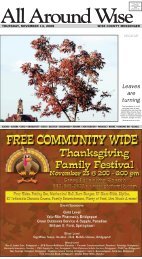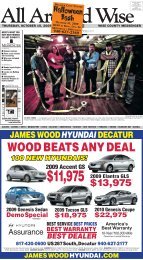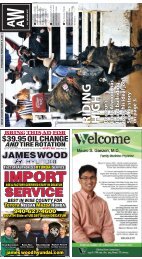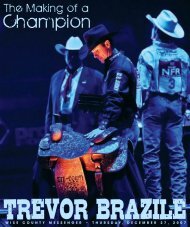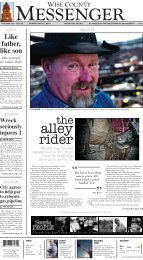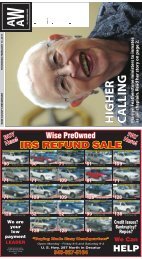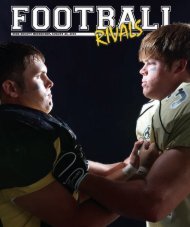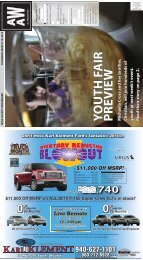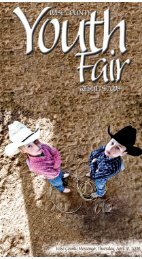2009 Welcome to Wise.indd - Wise County Messenger
2009 Welcome to Wise.indd - Wise County Messenger
2009 Welcome to Wise.indd - Wise County Messenger
You also want an ePaper? Increase the reach of your titles
YUMPU automatically turns print PDFs into web optimized ePapers that Google loves.
110<br />
WISE COUNTY His<strong>to</strong>rical Markers<br />
R. C. Mount House<br />
Mount Street, north of Chico<br />
A surveyor, part-time Methodist<br />
reacher, and <strong>Wise</strong> <strong>County</strong>’s first tax asessor-collec<strong>to</strong>r,<br />
R. C. Mount (1826-97)<br />
egan this structure in 1872 <strong>to</strong> house his<br />
arge family. Built of rock that Mount and<br />
is sons hauled by wagon from Palo Pin<strong>to</strong><br />
ounty, the original two-s<strong>to</strong>ry section was<br />
ompleted in 1874. Contrac<strong>to</strong>r H. A. Saye<br />
f Amarillo enlarged the house in 1890,<br />
nd further remodeling was done in 1920.<br />
Oak Grove United Methodist Church<br />
From Decatur, take Greenwood Road<br />
orth about 3.5 miles <strong>to</strong> church<br />
This congregation was organized in<br />
878 with fourteen charter members by<br />
he Rev. Jim Smith and the Rev. E. C. Fullngim.<br />
Oak Grove’s original sanctuary was<br />
onstructed 10 miles northeast of Decatur<br />
ut was moved <strong>to</strong> this site in 1902. The<br />
urrent church building has been in use<br />
ince 1948. Oak Grove United Methodist,<br />
hich traditionally held an August revival<br />
amp meeting, stands as one of the oldst<br />
rural churches in <strong>Wise</strong> <strong>County</strong>.<br />
First Post Office in <strong>Wise</strong> <strong>County</strong><br />
Marshall Drive and Rogers Road,<br />
ewark<br />
Established Sept. 8, 1855, in what was<br />
hen named Odessa. First white settler<br />
n <strong>Wise</strong> <strong>County</strong>, Benjamin B. Haney, was<br />
he first postmaster. Second was Martha<br />
. Marshall, appointed Dec. 5, 1856; third,<br />
athan Huff, served from March 16, 1860,<br />
ntil office was discontinued on Dec. 5,<br />
866. The second post office, Newark,<br />
pened in 1893, after another Odessa was<br />
ounded in Ec<strong>to</strong>r <strong>County</strong>.<br />
Siddons-Barnes Log Cabin<br />
Main Street, Chico<br />
This log cabin, believed <strong>to</strong> have been<br />
uilt in the early 1870s, was the first place<br />
f worship for area Methodists and served<br />
s a schoolhouse. Dr. J. A. Siddons and his<br />
ife M. E. Siddons purchased the cabin<br />
n 1883 and enclosed it with other rooms.<br />
n 1918 J. D. Barnes and Rachel Perkins<br />
arnes bought the property. The rooms<br />
urrounding the original log cabin were<br />
emoved in the 1970s. It was moved <strong>to</strong><br />
his site in 1987, and the fireplace s<strong>to</strong>nes<br />
ere res<strong>to</strong>red. The cabin features halfotched<br />
rough hewn oak logs, an interior<br />
oft, and measures 256 square feet.<br />
Old S<strong>to</strong>ne Prison<br />
201 E. Pecan Street, Decatur<br />
First s<strong>to</strong>ne house in Decatur. Erected<br />
y prison labor in about 1859. Main<br />
ouse was residence of sheriff or deputy.<br />
asement was used as jail. Meals were<br />
sent down a dumb-waiter located outside<br />
the east end of the house. <strong>County</strong> sold<br />
property in 1888 <strong>to</strong> A. H. Whitehead. Used<br />
as city water works until 1938. Kept as<br />
private residence until 1967 when purchased<br />
by <strong>Wise</strong> <strong>County</strong> His<strong>to</strong>rical Society<br />
as museum.<br />
Texas Tourist Camp and Texaco Petrified<br />
Wood Station<br />
904 S US 81/287, Decatur<br />
Built between 1927-1935, the Texas<br />
Tourist Camp consists of a collection of<br />
four one-s<strong>to</strong>ry and one two-s<strong>to</strong>ry wood<br />
and s<strong>to</strong>ne buildings that include a cafe,<br />
office/residence, two sets of cabins and a<br />
service station. The complex sits on the<br />
southeast corner of 2.5 acres along what<br />
was originally the Meridian Highway,<br />
then Highway 2 (now Business Highway<br />
81/287). Covered in assorted rock, primarily<br />
sands<strong>to</strong>ne and petrified wood, the<br />
buildings feature such details as arched<br />
porches and arched garage entrances,<br />
characterizing the complex as a group<br />
of early <strong>to</strong> mid 20th century roadside<br />
architecture buildings designed <strong>to</strong> service<br />
au<strong>to</strong>mobile travelers.<br />
S. W. Tilghman House<br />
309 E Shoemaker, Decatur<br />
Born in Gibson <strong>County</strong>, Tenn., S. W.<br />
Tilghman (1846-1913) came in 1870 by<br />
wagon train <strong>to</strong> <strong>Wise</strong> <strong>County</strong>. In 1872 he<br />
married a Decatur native, Eliza Bland<br />
Miller (1856-1931), and became father<br />
of a daughter and three sons. A master<br />
builder, he built this house in 1882 for<br />
his own family. Many of the city’s finer<br />
houses of the late 19th and early 20th<br />
centuries were built by Tilghman and his<br />
son Robert.<br />
Waggoner Mansion<br />
1003 E. Main, Decatur<br />
The Waggoner Mansion or El Castille,<br />
as it is sometimes called, is an excellent<br />
example of Texas’ finest Vic<strong>to</strong>rian masonry<br />
architecture. Built in 1883, the house has<br />
retained approximately 90 percent of its<br />
original craftsmanship and material. This<br />
percentage far exceeds most large Vic<strong>to</strong>rian<br />
homes of this nature that remain in<br />
such a good state of repair in Texas, and<br />
consequently by all means this home can<br />
be classified as being “authentic”. Both<br />
the exterior and interior walls are of solid<br />
poriferous limes<strong>to</strong>ne construction.<br />
The house contains a large basement,<br />
16 rooms and six and one-half bathrooms.<br />
There are two bedrooms downstairs and<br />
four upstairs.<br />
In the middle of the nineteenth<br />
century, Dan Waggoner drove a small<br />
herd of Longhorns in<strong>to</strong> <strong>Wise</strong> <strong>County</strong> and<br />
launched a successful career that by 1870<br />
earned him the recognition of being a<br />
“cattle kings”. At the time he built this<br />
baronial mansion it was the headquarters<br />
for the distinguished Waggoner Ranch<br />
which reached in<strong>to</strong> a seven county area.<br />
By 1900 the house was the headquarters<br />
for this well-watered and compact ranch<br />
that spread 30 miles east and west and<br />
25 miles north and south, and included<br />
over a million acres. The Waggoner Ranch<br />
supported over 60,000 head of cattle, and<br />
it was served by three separate railroad<br />
lines. Dan Waggoner died in 1904, and<br />
this house became owned by his son,<br />
William Thomas Waggoner. After oil was<br />
discovered on the ranch in 1903, development<br />
resulted in the founding of the Waggoner<br />
Refinery in 1911. The fortune which<br />
resulted from this cattle and oil base<br />
enabled the Waggoner Family <strong>to</strong> become<br />
one of the richest and most influential<br />
families in the Southwest.<br />
The moviemakers of the film “Giant”<br />
duplicated the exterior for the movie set.<br />
Thus, the Waggoner mansion is one of<br />
the foremost and striking architectural<br />
remains of the indelible marks left by the<br />
cattle empire of Vic<strong>to</strong>rian Texas.<br />
<strong>Wise</strong> <strong>County</strong> Courthouse<br />
Decatur<br />
The design of J. Riely Gordon for the<br />
<strong>Wise</strong> <strong>County</strong> Courthouse was similar<br />
<strong>to</strong> but not identical with his design for<br />
the Ellis <strong>County</strong> Courthouse. One of a<br />
number of Texas courthouses designed by<br />
J. Riely Gordon in a Romanesque Revival<br />
idiom, the <strong>Wise</strong> <strong>County</strong> Courthouse<br />
exhibits a number of characteristics of<br />
form, such as, the use of turrets, a <strong>to</strong>wer,<br />
broken massing and fine ashlar masonry<br />
of contrasting textures. In addition, it<br />
reveals the Greek cross plan developed by<br />
Gordon with access at the four reentrance<br />
and a central stair.<br />
Particularly distinctive is the fine<br />
masonry work throughout. Exterior walls<br />
were of Texas granite. The specifications<br />
called for “quality granite in two colors<br />
selected by the architect . . . laid up in<br />
pitch-faced and peen hammered alternating<br />
courses with pointed beds and joints.”<br />
The main columns were of polished pink<br />
granite. Terra cotta in the friezes, turrets<br />
and dormers was used extensively. For the<br />
roof, “the best quality Bangor slate of very<br />
light blue color” was specified.<br />
Inside, the courthouse was given the<br />
finest appointments including marble<br />
and granite floors and wainscots, indoor<br />
plumbing and electric lights. Water<br />
pressure was supplied by a large cypress<br />
cistern in the attic. Interior trim and doors<br />
were milled from oak, and the courtroom,<br />
complete with balcony, was furnished with<br />
fine oak furniture. Access <strong>to</strong> the upper<br />
floors was provided by a winding cast iron<br />
stair case in the building’s rotunda and<br />
that became a long spiral stair <strong>to</strong> provide<br />
access <strong>to</strong> the <strong>to</strong>wer. The <strong>to</strong>wer provided<br />
the building with natural ventilation, light<br />
by way of a glass skylight and housed the<br />
E. Howard and Company clock and bell.<br />
<strong>Wise</strong> <strong>County</strong> Reunion<br />
Farm Road 51, south side of Decatur<br />
at Reunion Grounds entrance<br />
The Confederate veterans of <strong>Wise</strong><br />
<strong>County</strong> are said <strong>to</strong> have held occasional<br />
reunions in the 1860s-1870s. Old settlers<br />
invited both the Confederate veterans and<br />
<strong>Wise</strong> <strong>County</strong> pioneers <strong>to</strong> an 1881 reunion<br />
at Cold Springs. This was on July 12, the<br />
anniversary of Capt. George Stevens’<br />
vic<strong>to</strong>ry over hostile Native Americans in<br />
1874. About 5,000 people attended the<br />
1881 reunion. The <strong>Wise</strong> <strong>County</strong> <strong>Messenger</strong><br />
reported a successful day -”only the<br />
music being a failure.” Events included<br />
speeches and picnicking. The reunion<br />
began <strong>to</strong> occupy the present site in 1896.<br />
By 1900 it extended <strong>to</strong> three days - honoring<br />
old settlers on the first, the veterans<br />
on the second and daughters and sons<br />
of Confederates on the third. Sometimes<br />
12,000 would attend, parading from<br />
courthouse <strong>to</strong> camp ground. Programs included<br />
candidates’ speeches, rodeos, and<br />
sham battles. Evenings were devoted <strong>to</strong><br />
visiting. In 1909, the grounds were leased<br />
for 25 years. Later, campsites were leased<br />
and improved by participants. The <strong>Wise</strong><br />
<strong>County</strong> Old Settlers Association, formed<br />
in 1904, sponsored a 1907 Pioneer His<strong>to</strong>ry<br />
by C. D. Cates. Extended <strong>to</strong> a week, with<br />
visiting in daytime and stated events in<br />
the evenings, this reunion is now the oldest<br />
recurring public event in the county.<br />
Sam Woody’s Cabin<br />
CR 4227, South of Decatur<br />
Tennessee pioneer Sam Woody (1826-<br />
1920) migrated <strong>to</strong> Texas in the 1840s. He<br />
brought his family <strong>to</strong> <strong>Wise</strong> <strong>County</strong> in 1854.<br />
This cabin, located near Deep Creek, was<br />
the first dwelling in the area. After Woody<br />
cut the logs, friends and relatives helped<br />
him erect the cabin in one day. Native<br />
Americans came here <strong>to</strong> trade buffalo<br />
robes and moccasins for corn. The house<br />
was frequently crowded with guests, for<br />
frontier travelers were never turned away.<br />
Woody guarded pioneer settlements as<br />
part of a Ranger unit and served in the<br />
Confederate army during the Civil War<br />
(1861-1865). Recorded Texas His<strong>to</strong>ric<br />
Landmark, 1970. The cabin is now located<br />
at <strong>Wise</strong> <strong>County</strong> Heritage Museum.




